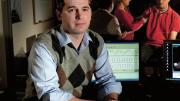A soldier who’s just returned from Iraq, unable to shake depression and violent flashbacks, ends his own life. A young mother, sleep-deprived and stressed by the emotional demands placed on her, harbors persistent thoughts of suicide. A 19-year-old college student, referred to a clinical psychologist after her roommate walks in to find her cutting at her wrists with a pocket knife, refuses to see the therapist, saying that cutting provides more emotional relief than counseling ever has.
What drives people to harm themselves, and how best to dissuade them from doing so, remains a mystery, says professor of psychology Matthew Nock. “More people die by their own hand than by someone else’s”--suicide is more common than homicide.“It’s a huge societal problem, a huge clinical problem, a huge research problem, and we know so little about it.”
The desire to unravel the mysteries of suicide and self-injury drives Nock’s work, which investigates the roles played by genes, environmental stressors, and momentary physiological experiences. He examines factors, such as gender, culture, and age, that affect suicide risk, and asks why certain populations (members of the U.S. Army, for one) are especially vulnerable. He aims to improve on existing treatments for suicidal and self-injurious thoughts and behavior, and to bring treatments that are already known to work to a larger number of patients.
His research involves a population that is inherently difficult to study, but Nock has viewed this challenge as an opportunity to innovate: to develop new methods and test novel applications for old ones. Work in his lab integrates methods from psychology, neurobiology, and epidemiology toward the goal of alleviating suffering and preventing the needless and devastating loss of life that suicide represents. It spans basic methodological research, inquiries into the nature and contributing factors of suicide and self-injury, and assessments of treatment effectiveness. This is what makes his work unique, says Jack Shonkoff, who directs Harvard’s Center on the Developing Child, where Nock is part of a working group on translating mental-health research to policy. For someone “at the forefront of knowledge generation,” such an interest in translation is rare, says Shonkoff, but Nock brings “an intellectual flexibility and sense of adventure” that are “refreshing and energizing.”
About 12 percent of Americans report having had suicidal thoughts at some point in their lives. Suicide itself often follows months or years of impaired productivity and quality of life, of strained relations with family members, as a person struggles with mental-health issues such as anxiety, depression, or substance abuse. Over the course of a lifetime, 5 percent of people attempt suicide, and about 1.4 percent of the U.S. population die this way.
Among people with suicidal thoughts, about one-third will make an attempt. To try to predict which third, Nock first looked to a population whose high risk was obvious: those who have already attempted suicide. (Two-fifths of those who kill themselves have tried before.)
For this purpose, Nock has adapted two computerized tests, both of which have been used for other purposes to detect subconscious thoughts and prejudices. The Stroop test, used in psychology since the 1930s, tests attention by asking subjects to override their most immediate thought processes and use higher-order thinking to identify the ink color of the printed name of a different color--for instance, to say “red” when the word “green” appears in red ink. Nock has used this test--measuring subjects’ speed at naming the ink colors of suicide-related words--and has found that with each millisecond of increase in the time it takes to respond to such words (indicating greater attention toward the words) came a 1 percent increase in the odds of the subject’s making a suicide attempt within the next six months.
Nock also adapted the Implicit Association Test--developed by Cabot professor of social ethics Mahzarin Banaji to measure people’s subconscious prejudices against various groups, including the overweight, the disabled, Arabs, and the elderly--for use in detecting whether people are predisposed to attempting suicide. When taking his test, those who are thinking about suicide respond more quickly when asked to pair suicide-related words with personally relevant words (e.g., “self”) than with non-personally relevant words (e.g., “them”). These tests are not ready for widespread use yet--for one thing, their predictive validity has not been proven for people who have not previously attempted suicide--but Nock is hopeful that one day they will be part of psychologists’ toolbox for assessing suicide risk in distressed patients.
Acknowledging Nock’s expertise in understanding who is at risk for suicide, a new partner recently called on his research team for help: the U.S. Army. The number of suicides in that branch of the military set new records in 2007, 2008, and 2009 (topping out at 162, up from 106 four years earlier). In June 2010 alone, the branch had 32 suspected suicides. If accidental death through risky behavior--such as drinking and driving, or drug overdose--is included, more soldiers now die by their own hands than die in combat. (From 2004 to 2007, the number of deaths in Iraq and Afghanistan across all military branches regularly approached or exceeded 100 per month, but the number of combat deaths has lessened in recent years.)
The researchers believe accidental deaths are rightly considered related to suicide, because such deaths often reflect soldiers’ mental health and indicate problems that accompany suicidal thinking and behavior. “Alcoholics get into more accidents,” says Ronald Kessler, a professor of healthcare policy at Harvard Medical School who is also part of the research team (see Harvard Portrait, November-December 2005, page 59). “It’s an accident, but there’s something systematic about it.” Traditionally, the military suicide rate has been below that of the general population, Kessler points out: “People in the military are screened very heavily” for mental-health problems. But that balance has switched: at Fort Hood, Texas, the largest army base in the United States, the suicide rate is four times the national average.
Alarmed by these statistics, the army is giving researchers from the University of Michigan, Columbia, and the Uniformed Services University of the Health Sciences, as well as Nock and Kessler, unprecedented access to the data it collects on soldiers. The army keeps records on “virtually every aspect of a soldier’s life,” says Nock; those records will be used to see what can be learned about suicides that have already occurred. In some cases, researchers will even examine brain sections of soldiers who committed suicide.
Beginning this month, they will also gather new data: they will invite 90,000 active-duty soldiers and all new recruits--80,000 to 120,000 per year--to volunteer biological data (e.g., information on genetic risk and protective factors gleaned from blood samples) and to grant access to their psychological histories and survey responses. The researchers will consider each soldier’s history of deployment and exposure to combat and trauma; family stability and childhood adversity; relationship problems and other sources of stress in the recent past; social support; and personality traits and temperament, as well as demographic characteristics.
The initial term of the study is five years, though there is potential to extend it and follow the soldiers longer. Given the robustness of the data and the potential for long-term analysis, the researchers believe this study’s impact could rival that of the famous Framingham Heart Study, which monitored thousands of residents of Framingham, Massachusetts, for decades and shed light on risk factors for heart attack and stroke, implicating hypertension, high cholesterol, and lifestyle factors.
That study, notes Kessler, “had to wait an awfully long time for people to have heart attacks. We don’t have to wait a long time. We’re hopeful that we’re going to be able to make not only important discoveries, but relatively rapid discoveries.” As results emerge, they will be used promptly to develop interventions; Nock notes that the army is already adding cognitive-skills training for soldiers, making a statement about the importance of mental and emotional, as well as physical, fitness. He and his colleagues will be able to evaluate army interventions and suggest improvements, based on their own studies’ emerging results, even as data collection continues.
Much remains unknown about suicide, and Nock admits that it is an inherently difficult phenomenon to study: “It’s not like depression, where people may experience the condition consistently for months or years at a time,” and thus can more easily participate in studies that aim to understand the condition. “Suicide happens quickly and unexpectedly.”
For this reason, and because the overall incidence is so low, most countries lack sound statistics. To try to understand more about differences among countries, Nock directs the suicide workgroup for the World Health Organization’s World Mental Health Survey (which Kessler leads). That study--the first large-scale, cross-national study of suicidal behavior--has thus far compiled data from 28 countries, many of which never gathered such statistics before. The study is especially valuable because it includes thousands of people who have attempted suicide; often, studies include so few suicide attempters that it is almost impossible to obtain statistically significant results.
The data already gathered have revealed striking country-to-country differences whose explanations are not well understood: the United States ranks in the middle when it comes to suicide rate, but it is among the highest (along with New Zealand, surprisingly) in the number of people who contemplate suicide. China and Italy are among the countries with the lowest rates of both suicidal thinking and suicide attempts. In most countries where statistics have been collected, women are more likely to attemptsuicide, but men are more likely to succeed--typically by a ratio of 4:1--except in China, where more women than men take their own lives.
And the study has already yielded one finding that overturned conventional wisdom. Because there is a strong association between depression and suicidal thinking, the psychology community assumed that depression would also be associated with suicide itself. Instead, Nock and his colleagues found that among people who are thinking about suicide, those who were depressed were no more likely to make an attempt than the others; rather, the factors that predisposed to attempting suicide were anxiety, agitation, poor impulse control, and use of alcohol and other substances. This pattern held true in all 21 countries examined. “In hindsight, it makes perfect sense,” Nock says. “Being depressed, being sad, ruminating on negative thoughts--it makes sense that that would get somebody thinking about suicide, but not necessarily acting.”
Although the suicide rate in the United States has not budged in the last hundred years, that is not because effective treatments don’t exist, Nock says. Two specific approaches-- cognitive behavioral therapy (which focuses on changing patterns of negative thinking) and dialectical behavioral therapy (which is similar, but incorporates a focus on accepting and tolerating difficult emotions)--have been shown to diminish the rate of suicide attempts among people who have already tried to kill themselves. The first has been in use since the 1960s, although its effectiveness with suicidal patients was shown only in 2005; the second was proved effective nearly two decades ago. But Nock says that “the majority of practicing psychologists aren’t using these treatments.”
Nock believes that allpsychologists who treat suicidal patients should use these approaches, which are laid out, specifically and clearly, in manuals that set forth what to do in each treatment session. In his effort to bring the treatments into wider use, he is starting with children, through his affiliation with the Center on the Developing Child. Avenues for possible action may involve working to change accreditation standards for training programs; amend licensing exams for clinical psychologists; and alter insurance reimbursement policies. Nock hopes this work on behalf of suicidal children will eventually translate into similar work for adults.
He once thought he would be practicing such treatments himself. “I wanted to learn about suicide because I thought it was probably the most difficult thing I would face as a clinician,” he recalls. He expected to find research dull, but once he realized he enjoyed it, he changed course. “Seeing a patient in my office for one hour once a week, I can certainly have an impact--I can observe it immediately--but the impact is not going to be as deep or as broad,” he says. (He did see patients for seven years, but gave up his clinical practice in 2005.) Nock first embarked on research to develop and evaluate treatments, but soon turned to more basic investigations of why people resort to suicide and self-injury. “If we can understand the behavior and develop better ways of detecting it and assessing it and preventing it and treating it,” he says, “we can help people all over the world.”










